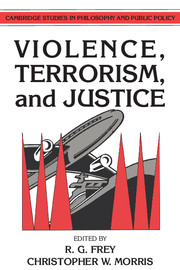Book contents
- Frontmatter
- Contents
- List of contributors
- Preface
- 1 Violence, terrorism, and justice
- 2 What purposes can “international terrorism” serve?
- 3 Violent demonstrations
- 4 Terrorism, rights, and political goals
- 5 The political significance of terrorism
- 6 Terrorism and morality
- 7 Which are the offers you can't refuse?
- 8 Making exceptions without abandoning the principle: or how a Kantian might think about terrorism
- 9 State and private; Red and White
- 10 State terrorism
- 11 Nuclear hostages
- 12 Rape as a terrorist institution
3 - Violent demonstrations
Published online by Cambridge University Press: 05 June 2012
- Frontmatter
- Contents
- List of contributors
- Preface
- 1 Violence, terrorism, and justice
- 2 What purposes can “international terrorism” serve?
- 3 Violent demonstrations
- 4 Terrorism, rights, and political goals
- 5 The political significance of terrorism
- 6 Terrorism and morality
- 7 Which are the offers you can't refuse?
- 8 Making exceptions without abandoning the principle: or how a Kantian might think about terrorism
- 9 State and private; Red and White
- 10 State terrorism
- 11 Nuclear hostages
- 12 Rape as a terrorist institution
Summary
When is life-endangering violence to be morally excused, or at least forgiven? Does the fact that what endangers human life is someone's violent or coercive action (hijacking a plane, shooting a hostage, planting a bomb in a store) rather than more insidious death dealing (laying down slow-acting poisonous wastes, using life-endangering chemicals in marketed meat and wine, selling human blood that one knows is infected with a fatal disease) make the death dealing more unforgivable? Does the fact that the killing is done openly, with an eye to publicity, make it better or worse than killings done quietly and with attempted secrecy? Does the fact that the terrorist typically identifies, to her victim and the world, the group on whose behalf she claims to act, that she, as member of that group, claims responsibility for what is done, make her better or worse than the intelligence agent who tries to kill anonymously or pseudonymously? The person we call a terrorist typically does her violence in the public eye, and lets the public know whose cause she believes to justify her violence. She is a violent demonstrator.
Like most demonstrators, she need not expect the demonstration itself to bring about the changes she demands. A successful demonstration gets attention. In one way or another it will be hoped that this attention will prepare the ground for other methods, either violent ones like assassination of leaders and armed uprising, or nonviolent ones like negotiation, legislation, or elections.
- Type
- Chapter
- Information
- Violence, Terrorism, and Justice , pp. 33 - 58Publisher: Cambridge University PressPrint publication year: 1991
- 1
- Cited by

